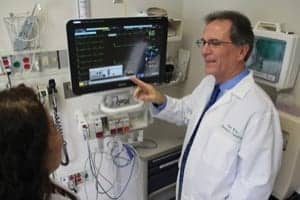By Dave Wiedman
Healthcare technology management (HTM) professionals are constantly looking for ways to reduce costs, streamline processes, and improve patient care—especially with the proliferation of expensive, mobile medical equipment. According to a study by GE Healthcare, the average number of devices per hospital bed has increased to 15, and utilization of medical equipment averages only 42%.
Oftentimes, mobile medical devices are not where caregivers and biomeds need them. Clinicians spend an average of about half an hour per shift trying to locate mobile assets, which impacts patient care. Eventually, a hospital buys or rents more equipment than they need, driving up capital purchases and overall operational costs.
Fortunately, the healthcare industry is adopting new technologies to improve the tracking and management of medical equipment with real-time locations systems (RTLS). RTLS offers healthcare providers dual savings for medical devices (optimize fleet management, reduce expenses) and increased staff productivity (reduce time wasted looking for medical supplies).
An AAMI eXchange 2021 presentation featured RTLS results from eight national healthcare systems. The “go-live” clinical case studies yielded $8.5 million in savings. As an example, a 500-bed acute care hospital can save approximately $696,000 and 365,000 staff hours annually.
Best practices’ for RTLS asset management from lessons learned at successful “go-live” deployments across nationally recognized healthcare systems include the following four key topics.
1. Discovering the Main Pain Points in Your Hospital System
In essence, poor asset management leads to decreased patient care, increased operational costs, and wasted time by critical hospital staff. First things first: You can’t go it alone when implementing an effective asset management solution at your hospital—it takes a village composed of key stakeholders committed to seeing its success and longevity.
Yet, no matter if you are a biomedical engineer, senior nurse, or the chief technical officer (CTO), it’s critical to understand the key pain points of mismanaged assets from these stakeholders’ perspectives. Asset management pain points typically involve lost or stolen equipment, increased rental costs, and decreased patient care.
2. Building the ‘A-Team’ Steering Committee and Stakeholders
Empowered with knowing your key stakeholders’ pain points and armed with proven results from these case studies, you can approach your supervisor and key executive leaders with clear value propositions on the qualitative and financial benefits to an RTLS system for their respective areas.
Your project’s executive sponsor should lead the committee, which will help garner support across the organization and communicate the “why” behind the project. Furthermore, a committee empowered by the hospital system’s executive sponsor will be able to make decisions and disseminate feedback from the hospital staff end-users. Additionally, this committee can respond quickly, make decisions, and implement changes that will keep the momentum of the project moving forward.
Biomedical engineers are key members of any RTLS steering committee because they are the ones on the front lines needing to find the equipment. They will spearhead asset-servicing for maintenance purposes and support the software adoption. Including them early in the implementation planning process is essential.
3. Selecting Equipment and Key Medical Devices for RTLS Tracking.
Now that you have your RTLS steering committee organized and hospital executive leadership excited and helping motivate staff, it’s time to pinpoint the exact medical devices and assets in need of tracking for maximum success. This is a pivotal moment in the lifecycle of an RTLS System because it sets up downstream for the standards and protocols, the workflow process ownership, and the key performance indicators (KPIs) to benchmark and track. We recommend conducting thorough analysis with your RTLS steering committee and inviting other key hospital stakeholders to help determine the right assets to track.
Typically, hospital systems will track assets that align their KPIs to those assets that overarch the three impact areas all key stakeholders focus on: improving patient care (nurse time savings for increased time with a patient), decreasing operational costs (rental/purchasing), and increasing patient satisfaction (care quality, hygiene standards).
4. Measuring RTLS Success with KPIs
What does success look like for your hospital system? It’s a simple, but powerful question that must be brought up early on with your hospital executive champion and your RTLS steering committee. Because no two hospital systems are alike in their needs, the assets they need to track and, thus, the KPIs they will measure, will differ. However, a common situation is that you will get numerous KPIs based on those assets that cover the three core areas all key stakeholders care about: patient care, time, and cost-savings.
In summation, utilizing RTLS to optimize asset management of a healthcare facility’s moveable medical equipment can help hospitals reduces costs, streamline processes, and improve patient care.
Dave Wiedman is chief commercial officer of Vizzia Technologies and a board director of the Georgia Biomedical Instrumentation Society. Questions and comments can be directed to 24×7 Magazine chief editor Keri Forsythe-Stephens at [email protected].



